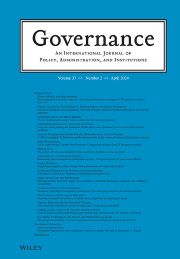Abstract
The study examines bureaucrats facing administrative architectures that are multiple, overlapping, ambiguous and sometimes incompatible. It makes two main contributions. Firstly, by an organizational approach it derives fine-grained predictions on how bureaucrats maneuver when taking part in integrated multilevel administrative orders. Secondly, benefitting from a large-N data-set (N = 4285) from 16 ministries and 47 government agencies in Norway, the study demonstrates how organizational factors systematically ‘moderate’ and bias behavioral perceptions among government officials. Moreover, to probe the robustness of explanatory models, the study specifies patterns of moderation by outlining multiple interaction models as well as illustrating how interaction effects unfold. The study finds that few moderators make dramatic effects by profoundly weakening relationships. Moderating variables either strengthen or attenuate already apparent effects, thus probing the empirical robustness of the models
Full info
Jarle Trondal og Gjermund Haslerud
Bureaucratic bias in integrated administrative systems: a large-scale study of government officials.
Governance, April 2024.
